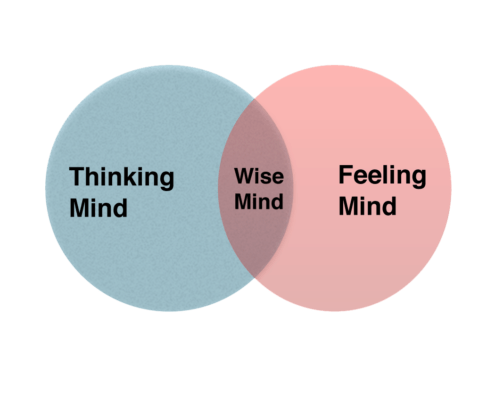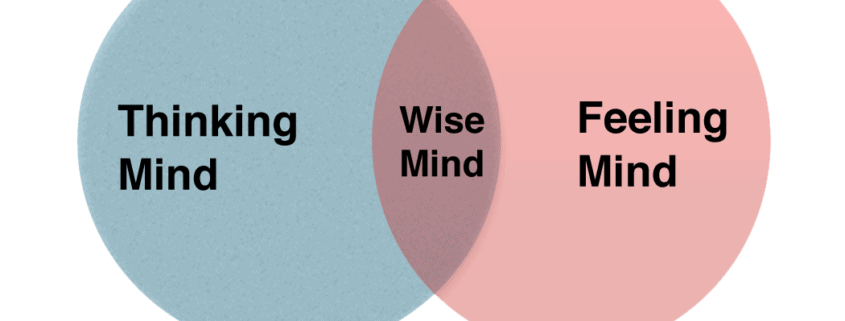Mindfulness and the Wise Mind
In dialectical behavior therapy (DBT), there is a wonderful explanation of how the best of our thinking and feeling minds can be accessed. This “Wise Mind” is based on the idea that the thinking brain and feeling brain both have validity and can be used to inform each other during difficult times.
Read about Flow Theory for another take on how the Wise Mind is a balance of two dynamics.
Thinking mind
The thinking mind does just that: It thinks thoughts. It uses logic, experience, etc. to make decisions. Very factual-based. For example, if you know you have six people eating dinner at your house, then you know that you’ll need 6 plates. The thinking mind also brings some much-needed logic to emotionally fueled decisions like how to handle a situation where somebody brings up a topic that isn’t really appropriate. Your feeling mind may feel embarrassment and/or anxiety; your thinking mind can help you improvise by gracefully changing the subject.
Feeling mind
The feeling mind does just that, too: It feels emotions. Eckhart Tolle teaches that emotions are the physical manifestations of thoughts; we feel them physically. When you have a stressful thought (thinking mind), like having too much work to get done in one hour, you feel your shoulders tense up, you may clench your jaw, etc. The common thread is tension in the physical muscle tissue. You feel the stress.
Wise mind
The combined experience of cognitive stress and emotional stress, plus some other factors, gives us a more inclusive experience of stress. If you ignore either side, you will have less information to help you decide your next move.
The Wise mind can be seen as the overlapping area between the Thinking and the Feeling minds. The amount of overlap, and which side has more influence changes with each situation.

Counseling helps you integrate your thinking and feeling minds into the Wise Mind.
“You think too much”
Ever been told that you think too much? You might experience this as “analysis paralysis;” this is when you see so many options that you try to think your way through the ins and outs of each and every option, to the point that you just short-circuit and don’t make a decision at all. Here’s a great parable demonstrating analysis paralysis:
A centipede is walking along and comes across a frog. Mr. Frog asks the centipede, “How do you know when to move each of those 100 legs? It seems quite confusing.” Mr. Centipede stops and responds to Mr. Frog, “Ya know, I’ve never really thought about it . . .” and then he thinks about it and says, “I guess I just do it.” Mr. Frog then says, “Ah. Good to know. Carry on.” Mr. Centipede then tries to walk away with his 100 legs, but cannot move. He looks at Mr. Frog and says, “Crap! Now that I’m thinking of what leg to move, I cannot move any of them!!”
GULP! Mr. Frog eats Mr. Centipede.
Sometimes, we need to use a great deal of the thinking mind, but in a tense situation, our ability to make a fast decision will involve intuition, which is a balance of thought and emotion.
Exercise
If you feel like you think too much, try practicing mindfulness of what your emotions are telling you in various situations. Don’t worry about accuracy, just notice your feelings, then allow your thinking mind to assign a word to that feeling (sad, glad, mad, scared, confused, etc). Writing these feelings down is just fine. Many find that very helpful.
“You’re too emotional”
Ever had people wonder why you get so upset at something? It may show up as road rage, or it could be that you take constructive criticism as a personal attack and break down into tears. Either way, the feelings are fine; it’s the intensity of the behavior that follows (uncontrollable sobbing, for example) that people are really noticing.
Let’s say the constructive criticism is from your boss. If you find yourself breaking down into sobbing when your job is not in jeopardy, etc., then your emotions may be leading your behaviors and your thoughts will help you keep things in perspective. In this example, being able to improvise (a fluid thought process) will help you let your boss know that you understand the issue and that you’re on top of it. Your heart may still be pounding, but your calmer response shows your boss as you’re somebody that can remain calm during emotionally intense situations.
In personal relationships, conflict can lead to very intense emotions. Being able to balance those emotions with effective thoughts helps you hear and understand the other person, which will help keep them calm and better able to hear and understand you. The wise mind is an important tool in communication.
Exercise
Notice what emotions come up in different situations (mindfulness). Jot down any patterns that stand out to you. Where do you remain calm, but could freak-out? Where do you freak-out, but probably don’t need to? Use your thinking mind to help you learn from those situations where you keep your cool. Begin to consider how you can use your thinking mind to counterbalance the situations where you may overreact. With road-rage, for example, you can practice realizing that the other driver may be racing to the hospital, etc. While it may not justify their dangerous driving, it helps you keep calm and not join in the danger by adding road rage.
Learn more about Mindfulness-based Counseling in Austin.
Jonathan F. Anderson, LPC-s has worked in the helping profession since he started college in 1990. After completing his Bachelor’s degree at the University of Texas, Austin in 1994, he attended the highly-regarded University of Minnesota to earn his Master’s degree in 1997. He is a Licensed Professional Counselor and is recognized as a Board Approved Supervisor by the State of Texas Board of Examiners of Professional Counselors. Jonathan has completed Level-2 of the Gottman Method of Couples Counseling, and in 1998 received training by the International Critical Incident Stress Foundation in Advanced Critical Incident Stress Management & Debriefing. To learn more about Jonathan’s practice, click here: Jonathan F. Anderson, LPC-s.



